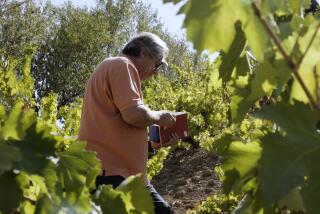A crisp Txakoli serves as a perfect summer wine
- Share via
When the thermometer goes up, it’s time for crisp summer whites to step out.
Some wine drinkers stick with white year round and know exactly what they like, whether it’s a steely Chablis, a lighthearted Pinot Grigio or a buttery California Chardonnay. Die-hard red wine drinkers, though, are often at a disadvantage, casting around for something — anything — to slake their thirst. If anyone’s asking, I might steer them toward Spain and a crisp, bone-dry, slightly saline Txakoli (a.k.a. Txakolina) from the Basque country on the northern coast of Spain. And since Txakoli is generally low in alcohol, it’s the perfect summer wine.
The vineyards of Getariako Txakolina, one of three sub-zones that make up the appellation, are planted on bluffs above the blue-blue Bay of Biscay just west of San Sebastian and its thrilling restaurants. And the wine picks up a little of that salty character from the breezes coming off the Atlantic. Made from two indigenous grapes, primarily Hondarrabi Zuri with a little of the red grape Hondarrabi Beltza, Txakoli (pronounced cha-co-lee) or Txakolina (cha-co-lee-na) is everything you want in a summer wine — crisp, minerally, ever so slightly tingly.
If you visit the vineyards there, vintners will show how the Basques drink the popular wine, pouring it from a height into flat-bottomed tumblers. This aerates the wine and gives it the slightest prickly fizz, making it even more refreshing. The key is to pour it from 10 to 12 inches above the glass, not more, so you get a little bit of foam, but not too much.
In the Spanish Basque country, whenever people get together, they drink Txakoli — at brunch and also with a snack in between lunch and dinner. And then again with pintxos or tapas before dinner. At the Ameztoi wine estate near the town of Getaria, I once was served their wines with local salt-cured anchovies slicked with a little olive oil, accompanied by slices of crusty bread. The anchovies from this part of the world are extraordinary, and the combination with Txakoli is brilliant. It works like Barbera with salumi. The bright, singing white wine plays against the fat brininess of the anchovy, leaving you eager for the next bite, the next sip.
Basques will swear by Txakoli not only with anchovies but also with tuna and all the seafood served up in the fishing village’s rival fish restaurants: Elkano and Kaia. Its minerality and saline quality make it a perfect match. If you go pintxos-hopping in San Sebastian’s Parte Vieja, every bar is pouring Txakolina.
Maybe it is the proximity to the sea that makes this wine so attuned to seafood. The vineyard sites near Getaria are magnificent, especially in summer, when rows and rows of green vines comb the steep, difficult-to-work hillsides. Our guide at Ameztoi explained that the grapes from vineyards near the sea are more acidic and salty, and they form the base of the wine. That’s blended with grapes from the other side of the mountain, where vines get more sun and therefore more sugar.
Vines have been grown in this area as far back as 1649, according to local archives, but the appellation was established only in 1989. Until then, most of the producers were very small scale. For the most part, they still are. Txomin Etxaniz is one of the largest. But even there, grapes are picked by hand, with only small tractors to help out in the vineyard.
Though the Basques are crazy about Txakoli and drink most of the production, it has been making its way to the U.S. Though until very recently Txakoli was an obscure wine stocked by only a few wine shops, this year I’ve found it at a great many more shops, and some may have as many as half a dozen labels. Prices have crept up too with Txakoli’s newfound popularity, but it’s still very affordable.
Just remember to serve the wine well-chilled. And to lay in some salt-cured anchovies.
More to Read
Eat your way across L.A.
Get our weekly Tasting Notes newsletter for reviews, news and more.
You may occasionally receive promotional content from the Los Angeles Times.










